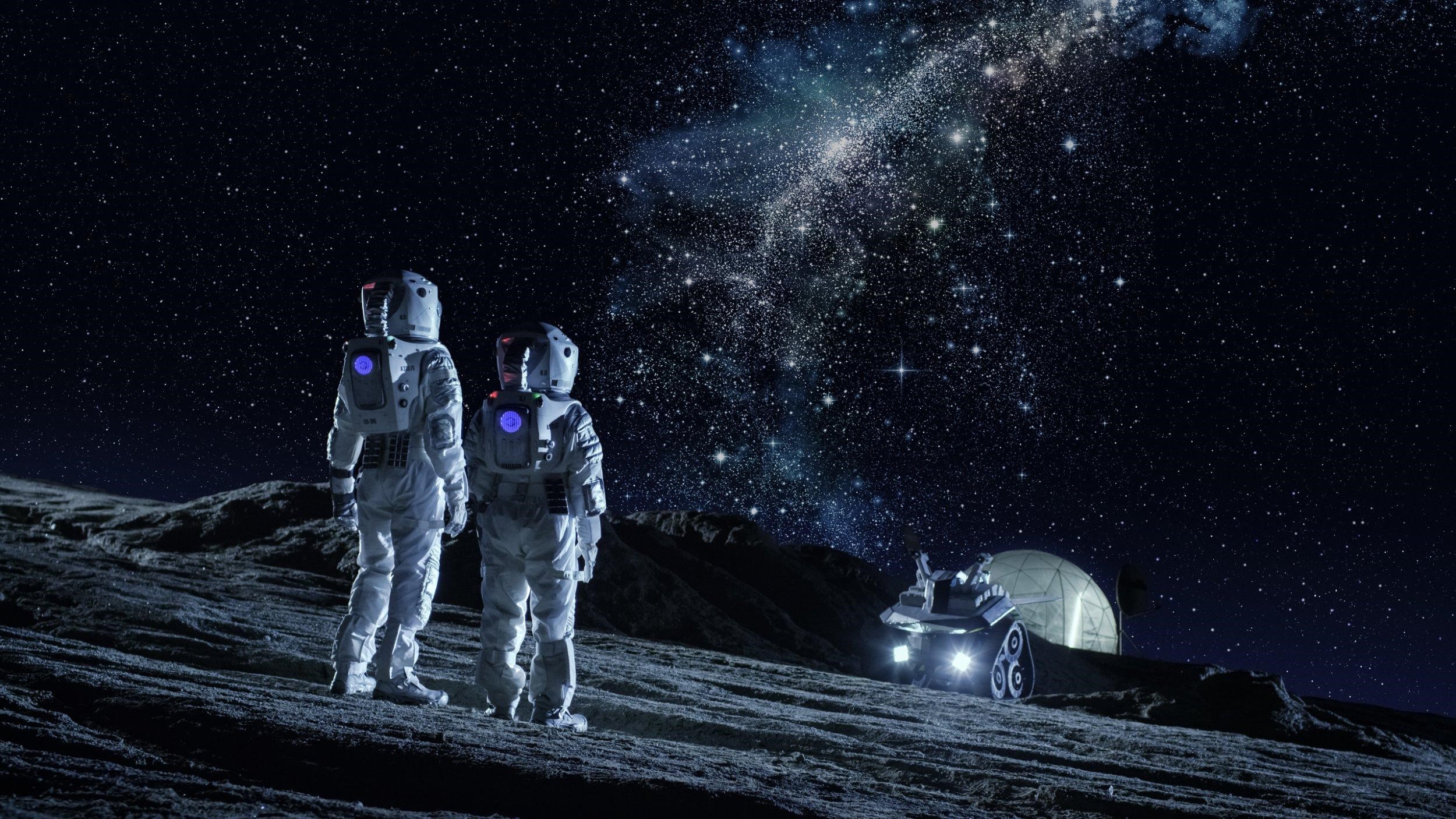
Space exploration is the most striking example of the triumph of human intelligence and its perseverance in exploring the unexplored corners of the universe. Not so long ago, just over a century, the ‘flight to the stars’ was the prerogative of science fiction writers, but already by the late 1950s the first man-made object had overcome Earth’s gravity and entered Earth’s orbit. Thus began the space race.
In less than seven decades, man has succeeded in building an incredible space station, walking on the Moon and photographing its dark side, peering into the depths of the universe through the Hubble telescope[1] and seeing images of other galaxies thanks to the ‘James Webb’ telescope[2] to launch artificial satellites and to see details of Jupiter, Saturn, Mercury, to give birth to space tourism, to learn to stay in space as long as one wants and to think seriously about colonising other planets[3].
By the end of 2022, more than 260 different space exploration vehicles and satellites had been launched by different countries[4]. Not all of them were successful, but certainly each one represented a small step on the road to space exploration. Advances in rocket technology and space navigation were the key factors that enabled spacecraft to travel great distances and make many scientific discoveries. Important factors were: the development of powerful rocket engines, the development of space navigation and communication, and finally the development of special antennas and data transmission technologies that enabled spacecraft to determine their position and communicate with the Earth over long distances[5].
Flight to the furthest regions of the Solar System is also made possible by the discovery of ‘gravity assist’. This is a method of using the gravitational field of a planet or other large space object to change the speed and direction of flight of a spacecraft. When a spacecraft approaches a planet, it uses that planet’s gravitational field to gain additional speed, saving fuel and the time needed to manoeuvre through space[6]. In real life, this technique is perfectly illustrated by a game of billiards on a game board.
Towards the stars

The unknown area at the edge of the Solar System[7]
In March 1972, NASA’s Pioneer 10 space programme launched a spacecraft that, for most of its mission, was the farthest thing from Earth ever built by man. It was the first spacecraft to pass through an unknown asteroid belt and approach Jupiter, in December 1973[8]. Its main purpose was to study the gas giant, its satellites, its trapped radiation belts and its magnetic field[9].
The spacecraft was equipped with a complex of 11 research instruments to carry out the planned research. At the beginning of December 1973, Pioneer 10 was at the closest point to Jupiter, at a distance of about 132,000 km, and at the time of approach, all systems were functioning properly. “Pioneer” managed to get close to the planet, collect the necessary data and, at the end of its journey around the gas giant, return 500 images of the planet and its satellites to Earth[10].
Pioneer 10 sent its last data in 2002 and received its weakest signal in 2003, 31 years after launch, when it was 12.21 billion km from the Sun. The presumed cause of the communications breakdown is the depletion of the power source (the portable nuclear reactor). Pioneer 10 is probably continuing its journey towards the star Aldebaran, beyond the Solar System, and if it does not encounter any obstacles in its path it will reach the vicinity of the star in about 2 million years[11].
The Pioneer 11 probe was launched by NASA in April 1973. Its task was to explore the outer solar system and Jupiter’s ecosystem. The additional mission was to fly to Saturn and study its rings and satellites. Pioneer 11 was equipped with the same research instruments as its predecessor[12]. The probe approached just 42,500 km from Jupiter, three times closer than its predecessor, took numerous photographs of the gas giant (including the planet’s pole) and its satellites, and, on the basis of the data collected, drew conclusions about the boundaries of Jupiter’s magnetosphere.
Exploiting Jupiter’s gravitational field, the probe plotted a course for Saturn, which it approached almost five years later. There it obtained more than 400 images of the planetary system, was able to ascertain the total temperature of the planet and its main satellite Titan, and discovered a new satellite, drawing new and surprising conclusions about Saturn’s atmosphere and its magnetic field[13].
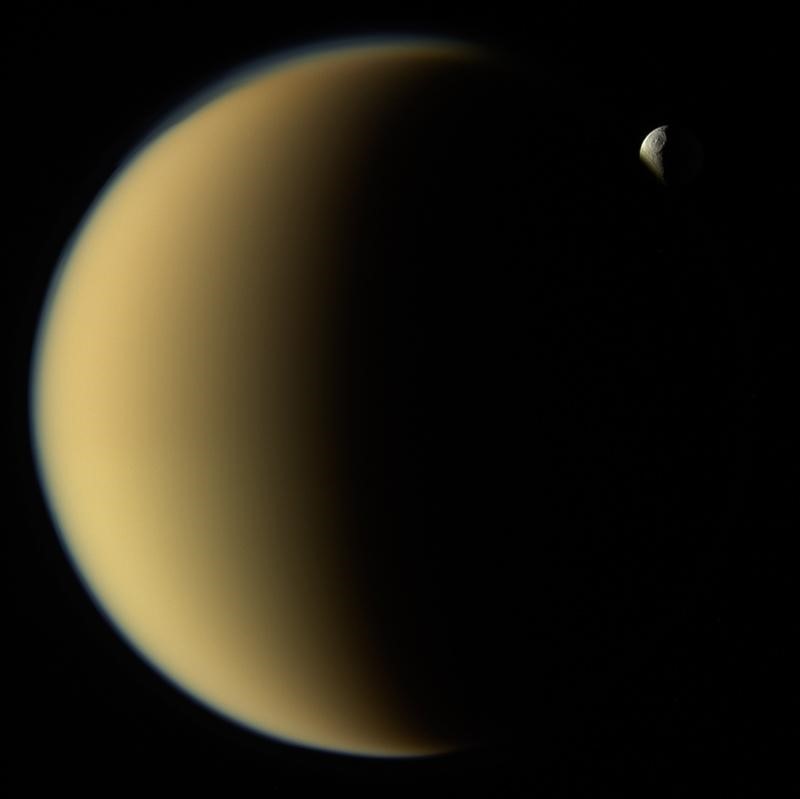
An image of Titan taken by Pioneer 11[14]
After leaving Saturn, Pioneer 11 flew in the opposite direction to its predecessor, towards the star Deneb in the constellation of Aquila, which it should reach in about 4 million years[15]. Twenty-two years after its launch, Pioneer 11 is still carrying two instruments and its last successful communication session took place in November 1995[16]. But the flight continues. In the event of an encounter with an extraterrestrial civilisation, both Pioneers carry a gold plaque depicting the spacecraft itself, a man and a woman, and a hydrogen atom of the planets of the solar system, with the position of the Earth marked[17].
In effect, the Pioneer probes were preparing a safe path for the other two space explorers. In 1977, NASA’s Voyager programme, created to explore the outer planets of the solar system, launched two space probes with the same name: ‘Voyager 1’ and ‘Voyager 2′. Their goal is to gather as much information as possible about the outer gas giants of the solar system. The launch was planned to take into account the orbital positions of Jupiter, Saturn, Uranus and Neptune, so that the spacecraft could use the planets’ gravitational fields to manoeuvre and adjust their speed[18].
Today, the technical equipment of those space probes might raise eyebrows, but in 1977 they were the flagship of the space industry. The scientific equipment is the same as their predecessors, Pioneer 10 and Pioneer 11, and the power source is also a radioisotope thermoelectric generator. Since the probes must reach the furthest points of the solar system, great attention has been paid to the communication systems, especially the antennas. The computer system consists of three independent computers, each with its own function: control and monitoring of the spacecraft’s status, processing and transmission of telemetry, and control of the attitude control system and research instrument platform[19].
Less than two years after its launch, Voyager 1 reached Jupiter and continued on to Saturn, which it reached in November 1980. The probe then used gravitational manoeuvring to gain the speed it needed to follow its trajectory away from the solar system[20].
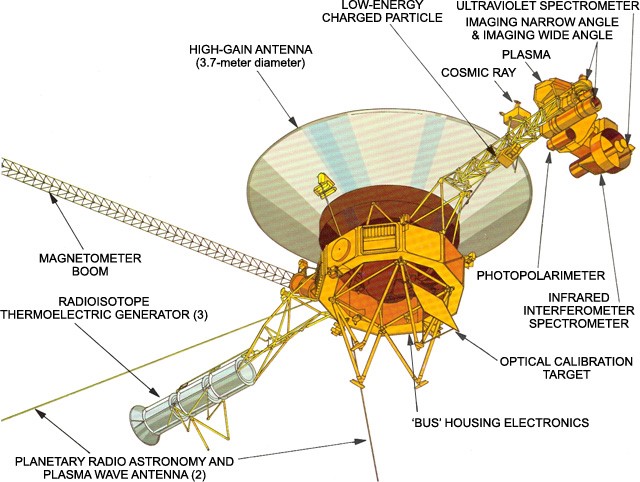
Voyager’s equipment[21]
Voyager 2’s journey was more measured and longer: it passed Jupiter in the summer of 1979 and Saturn’s rings in the summer of 1981, headed towards Uranus, which it reached in January 1986, and then approached Neptune in August 1989. After such a long journey of exploration, the probe headed for interstellar space. “Voyager 2 is the only man-made probe to have reached the last two planets of the solar system, Uranus and Neptune[22].
Voyager has done an incredible job. It has collected a wealth of data on the atmospheres of the four giants of the solar system, such as the turbulent atmosphere of Saturn or the transforming rings of Jupiter, the numerous poles of the two planets, the fact that they emit 2-2.5 times more energy than they receive[23], the discovery of more than two dozen new moons and satellites, the images of the numerous lakes and rivers of hydrocarbons on their surfaces, and the discovery of active volcanoes on Jupiter[24].
25 August 2012 is an important moment for the Voyager 1 space probe, as it was on 5 November 2018 for its sister spacecraft, which entered interstellar space[25]. This ‘exit’ means that the probe has succeeded in crossing the heliopause, the boundary of the heliosphere, the region dominated by the solar wind and its associated magnetic fields[26].
The Voyager interstellar mission has no definite time limit. Both probes are still operating and sending data back to Earth, which scientists continue to analyse. The Voyager probes are expected to continue operating until at least 2025, when the instruments on board are expected to run out of resources. However, the Voyager probes could continue to operate and transmit data for several years after that, until the probes’ energy resources are exhausted[27].
For now, almost 46 years after their launch, the Voyager 1 and 2 probes are communicating, are active, and are 23.82 billion and 19.93 billion km away from Earth respectively, and reaching the outside of the solar system remains the primary goal of their mission for the next few hundred years at best[28]. So far, no man-made object has left the solar system. These are our new Pillars of Hercules: we can only guess what lies beyond, and Voyager, if we are lucky, will be man’s first journey beyond this boundary[29].
Beyond the new Pillars of Hercules
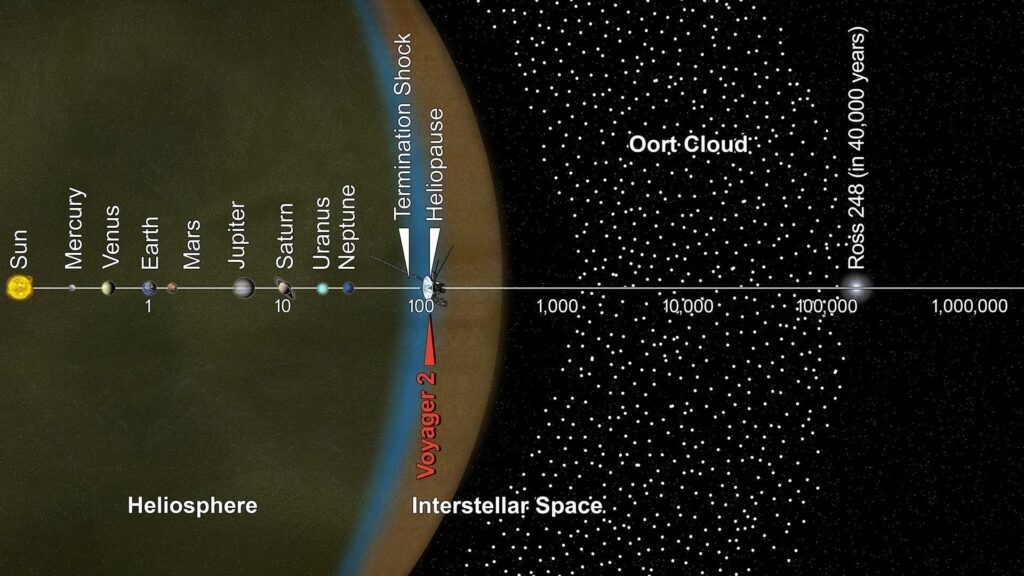
Solar system diagram showing the current position of Voyager 2[30]
The Solar System comprises all bodies that are subject to the Sun’s gravity, that orbit around it and that are attracted by its gravity[31]. The hypothetical boundary of the Solar System is the Oort Cloud, the outermost part of which is presumably at a distance of 100,000 astronomical units (a.u.) from the Sun[32] (1 a.u. is equal to the average distance between the Earth and the Sun, almost 150 million km)[33].
The system in which we live resembles a multi-layered sphere. Beyond the orbit of the last planet, Neptune, lies the Kuiper Belt, a disc-shaped region containing millions of icy bodies, remnants of the formation of the solar system[34]. It was there, towards the distant dwarf planet and the unexplored region, that NASA’s space programme sent the New Horizons probe in 2006. The probe is tasked with studying the atmospheric and geological characteristics of Pluto and its moon Charon, as well as other objects in the Kuiper Belt. To support the mission, the probe was equipped with seven scientific instruments: three optical systems, two plasma analysis systems, a dust analyser and a radio spectrometer[35].
The probe completed its mission: while flying over Jupiter, it was able to detect the planet’s global climate changes and discovered lightning in the polar regions for the first time, studied the surface and atmosphere of Pluto and Charon in detail[36], collected data on many other satellites, took incredible pictures of distant objects in our solar system, and also collected a series of data whose analysis made scientists reconsider previous models of the system[37]. It then proceeded to the Kuiper Belt object Arrokot, successfully reached in January 2019, discovering a previously unseen space object[38].
New Horizons is now in ‘hibernation mode’ at a distance of over 7 billion kilometres from Earth and was due to be activated on 1 March 2023. In the future, New Horizons could be sent to explore other objects in the Kuiper Belt[39]. The probes tasked with exploring the furthest reaches of the Solar System share similarities in technology: they use thermal isotope generators (powered by Pu38), as it does not make sense to use solar panels at greater distances from the Sun; they are equipped with highly sensitive scientific instruments: (a) Plasma sensors and detectors to measure the density, temperature and speed of plasma in space; (b) Magnetometers to measure the intensity and direction of the magnetic field; (c) Instruments for measuring cosmic radiation, including cosmic ray detectors, gamma ray detectors and spectrometers; (d) Ion and neutral detectors to study the composition of the gaseous environment; e) Cameras to photograph planets, moons and other objects close to the spacecraft; f) Spectrometers to study the surface composition of planets and moons; g) Instruments to measure temperature and thermal radiation; h) Antennas and radio wave receivers for communication with Earth; i) Gas analysers and mass spectrometers to study the chemical composition of the atmosphere of planets and moons; j) Instruments to measure the speed and direction of the spacecraft[40].
To ensure communication, the orientation of the probe with respect to the Earth is very important and probes are equipped with autonomous orientation systems. Most often, optical sensors are used that respond to light (from the Sun or bright stars such as Sirius), so that the spacecraft can transmit a signal in the direction of the Sun and thus the Earth[41]. Naturally, each successive spacecraft is superior to the previous one in terms of technical equipment and the quality of materials used, as technological advances do not stop and new instruments are added with each new mission.
Wandering in space

A hypothetical image of our Solar System seen from the outside[42]
Space exploration continues. Scientists’ attention is focused on studying the interaction between the solar system and the interstellar medium. Two NASA missions are currently active in this area: the Interstellar Boundary Explorer (IBEX) – launched in 2008[43] – and the Parker Solar Probe – to study the Sun and its corona, and to obtain data on the Sun’s interaction with the interstellar medium near the outer Solar System[44].
Communication is a critical link in all interplanetary missions. If contact is lost with the spacecraft, no matter how efficient it is, it becomes useless to Earth, as does the data collected, which cannot be transmitted. Radio communication is used to communicate with spacecraft. It works by oscillating the current in the transmitter antenna to create electromagnetic waves that propagate almost at the speed of light and reach the receiver antenna. The receiver is tuned to the frequency of the transmitted radio wave and the result is an alternating electric current in the antenna that is then amplified, analysed and used to transmit information[45]. This process enables information to be transmitted over long distances in space[46].
To perform this process, space probes are equipped with special antennas and transmitters. These antennas are usually mounted in a specific direction to improve signal quality. In addition, probes are usually equipped with several antennas positioned on different sides of the body to ensure communication at any position of the probe relative to the Earth. Another very important factor for space-to-ground communications on spacecraft is system redundancy, i.e. the use of a low-speed communication channel (antennas not oriented towards Earth) and a fast, narrow-direction information transmission channel.
In the event of faults, which result in the loss of orientation, or conflicting requirements for the position of the vehicle (the solar panels versus the light, the engine versus the manoeuvre being performed, the scientific equipment versus the object being studied), or when using the ‘sleep’ mode, in these cases the redundant slow communication channel becomes an opportunity to transmit ‘vital’ information and, if necessary, using commands from the Earth, a way to bring the vehicle back to full functionality[47]. For example, the 4.8 metre antenna of the Galileo station (NASA’s robotic spacecraft for the exploration of Jupiter and its satellites) failed to open in flight. Fortunately, the station was connected to Earth via a non-directional channel at only 160 bps instead of the 134 kbps expected during its eight-year stay on Jupiter, and continued to operate, albeit at a low transmission rate[48].
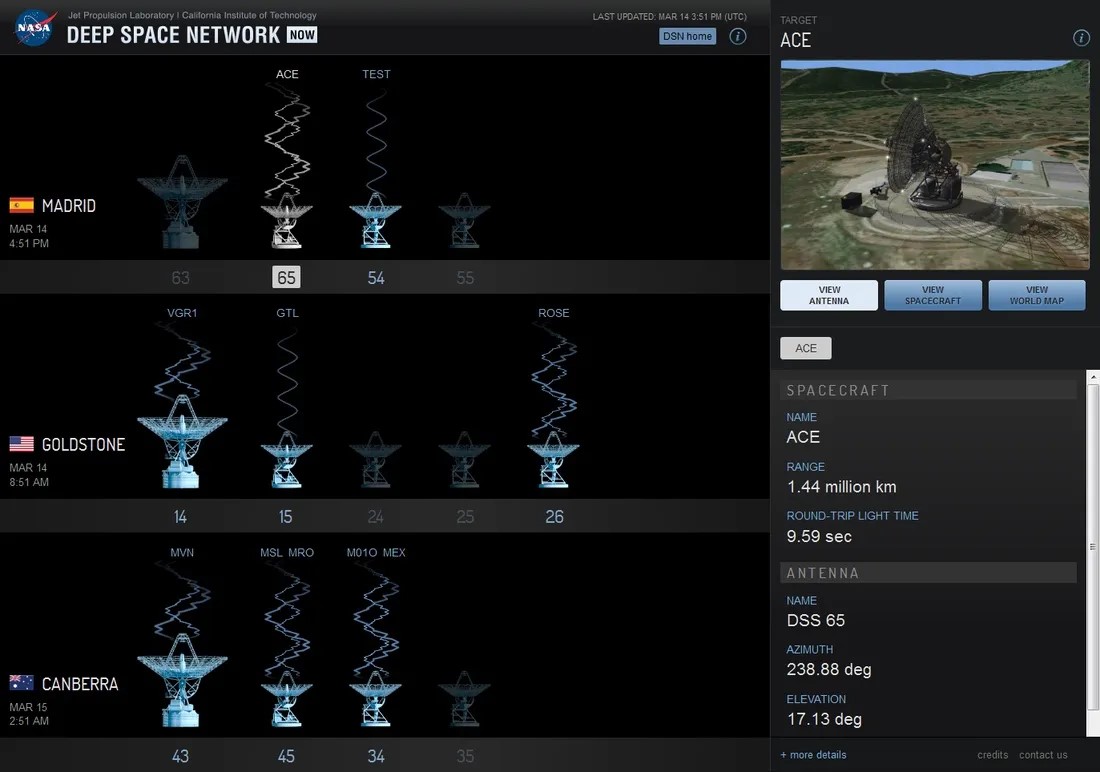
The NASA DSN in real time[49]
The further interplanetary stations move away from Earth, the more difficult it becomes to pick up their signals. Unfortunately, we cannot yet scatter our solar system with orbiting satellites to act as repeaters everywhere, so we have to build huge satellite dishes[50].
NASA’s Deep Space Network (DSN) is the largest and most sensitive scientific telecommunications system in the world, consisting of giant NASA radio antennas forming three equidistant sites – at about 120 degrees longitude – around the globe. The sites are located in Goldstone, California; in Madrid, Spain; and near Canberra, Australia. This location is due to the need to ensure uninterrupted communication with spacecraft during the rotation of our planet. If the signal is lost at one location, another station picks it up and continues communications[51].
For example, the main parabolic antenna of the Madrid Space Communications Complex, DSS-63, has a mirror diameter of over 70 metres and weighs 3500 tonnes. To track the probes, the antenna rotates on four ball bearings, each weighing one tonne. However, finding small objects in space to accurately point the huge antenna is a very difficult task, so they resort to ‘radio triangulation’, in which two ground stations compare the exact angle at which a signal hits the mirror of the antenna at different intervals. In this way, the distance to an object and its position can be calculated[52].
The DSN is not only a set of large antennas, but also a powerful system used to control, track and monitor the condition and safety of spacecraft at many distant points in the solar system. The not-so-distant communication can be done using Estrack (tracking stations of the European Space Agency), a worldwide system of ground stations connecting satellites in orbit to the European Space Operations Centre (ESOC) in Darmstadt, Germany. It consists of seven stations located in different countries, including three deep space antennas.
The speed at which information is transmitted is a key factor in the communication system. It does not depend so much on the signal strength as on the ratio between the signal amplitude and the noise that interferes with reception. Noise is due to the thermal movement of atoms in receiving and transmitting equipment, and space is anything but ‘silent’: microwave radiation, left over after the Big Bang, ‘sings’. Space information is transmitted in digital form, i.e. in a sequence of zeros and ones – the bits – and the worse the signal-to-noise ratio, the longer it takes to transmit each bit. Therefore, the further away the device, the weaker its signal, the slower the exchange of information with it[53].
The Voyager probes, which have a parabolic antenna with a diameter of 3.65 m, prove this: during the orbit around Jupiter and Saturn, when the satellites were close enough to Earth, data rates of 115,000 and 45,000 bps were achieved. But since signal strength varies inversely with the square of the distance between transmitters, Voyager 2 transmitted at 9,000 bps during the Uranus survey. At Neptune, the number dropped to 3000 bps[54]. Over 23 billion km away, Voyager 1 transmits at 160 bps, with a one-way transmission time of 20 hours and 33 minutes[55], while a ping from Mars, travelling at the speed of light, takes only 20 minutes to reach Earth[56].
Planetary exploration
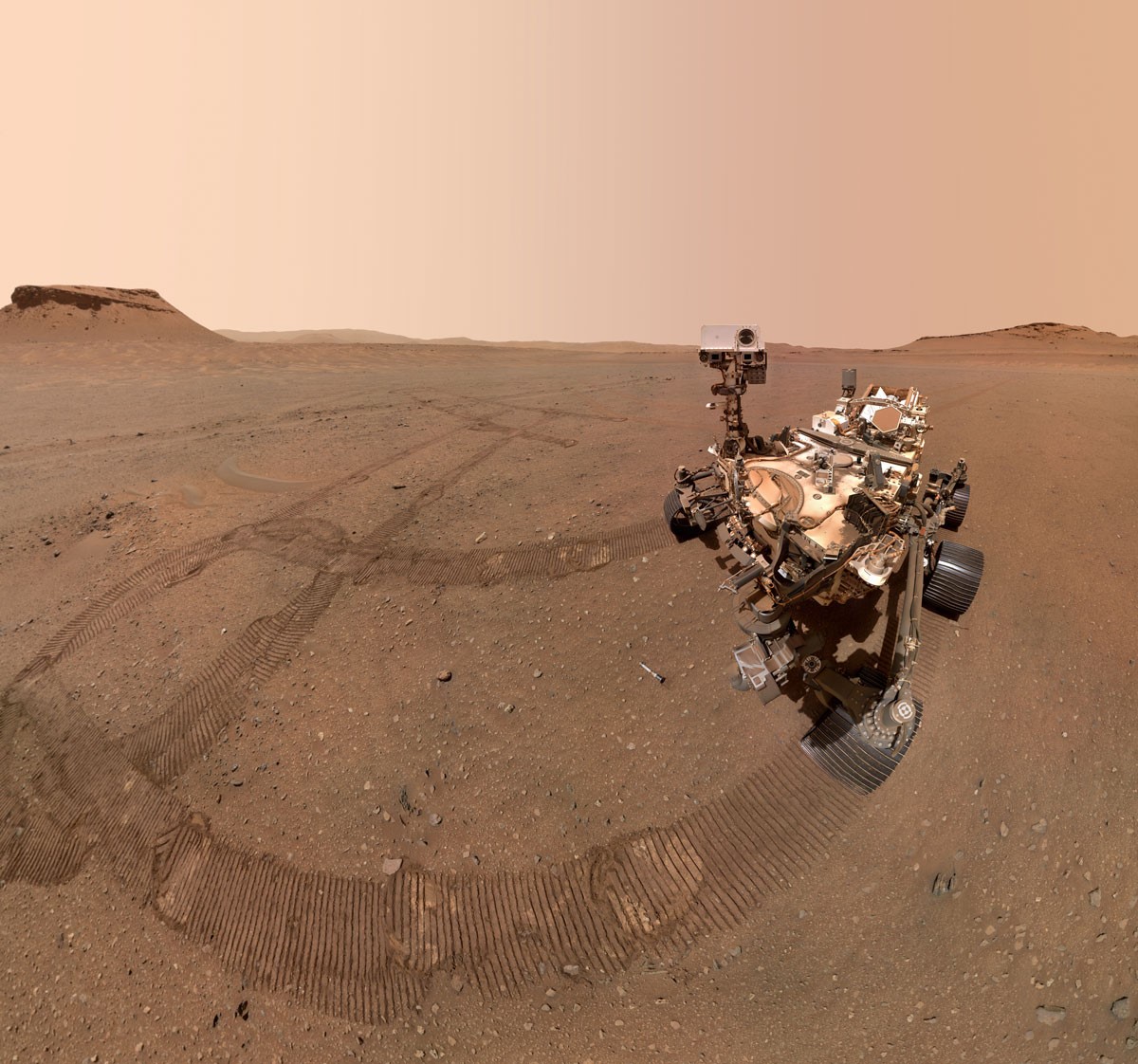
NASA’s Perseverance rover took a selfie with one of the 10 sample tubes it placed in the sample vault[57]
All of this serves to better understand the nature of our solar system, its origin and evolution, to study the laws operating within it and to determine the potential usefulness for mankind, as well as the possibility of life forms on other objects in space. The exploration of the surface of objects in the solar system, on the other hand, has different objectives, and for this reason the spacecraft used are different.
Research on our lunar neighbour aims to study the structure and composition of its surface and to search for resources needed for future space missions. The Yutu 2 Chang’e-4 lunar rover is a Chinese unmanned vehicle that was launched in December 2019 and made a soft landing on the back side of the moon. The lunar rover, which weighs 140 kg, runs on solar panels and, like its module, operates for about two Earth weeks when the sun shines and then shuts down to survive the long, cold lunar night. So far it has travelled more than 1 km on the Moon and[58], among other discoveries, has found two semi-transparent glass spheres, probably formed by volcanic rocks caused by meteorite impacts[59].
In 2011, NASA’s Mars Science Laboratory sent Curiosity, the largest and most powerful rover ever sent to the ‘Red Planet’. Its mission is to answer the question: have environmental conditions on Mars ever been suitable for microbes?[60] It is equipped with an array of 10 scientific instruments, 17 cameras, a laser to vaporise and study rocks, and a drill to collect crushed rock samples. Already in the first year after landing on Mars, scientists found evidence of an ancient bedrock and soil samples taken from the planet contained about 2% water. In 2022, the results of a study of rocks taken from the Glen Torridon region of Gale Crater were published. The research indicates that Mars once had lakes and hot springs, which is confirmed by the presence of structures and interlayers with a high fluoride content, similar to those that form at the bottom of lakes on Earth. In addition, scientists have detected oxygen, carbon dioxide and sulphur on Mars using the Sample Analysis at Mars (SAM)[61].
In 2020, as part of the same project, the Perseverance rover was sent to continue the mission of its predecessor. The rover is equipped with a drill to collect rock and soil samples from Mars and store them in sealed tubes for a future mission to bring them back to Earth for detailed analysis. The mission plan also includes identifying other resources (such as groundwater), characterising weather, dust and other potential environmental conditions. Its task is also to test the ability to produce oxygen from the carbon dioxide in the Martian atmosphere[62].
The European Space Agency’s two-stage ExoMars programme promises to answer the question of whether life ever existed on Mars. The Trace Gas orbiter was launched in 2016 and the second part of the programme, which includes a rover and an Earth platform, is awaiting launch confirmation[63].
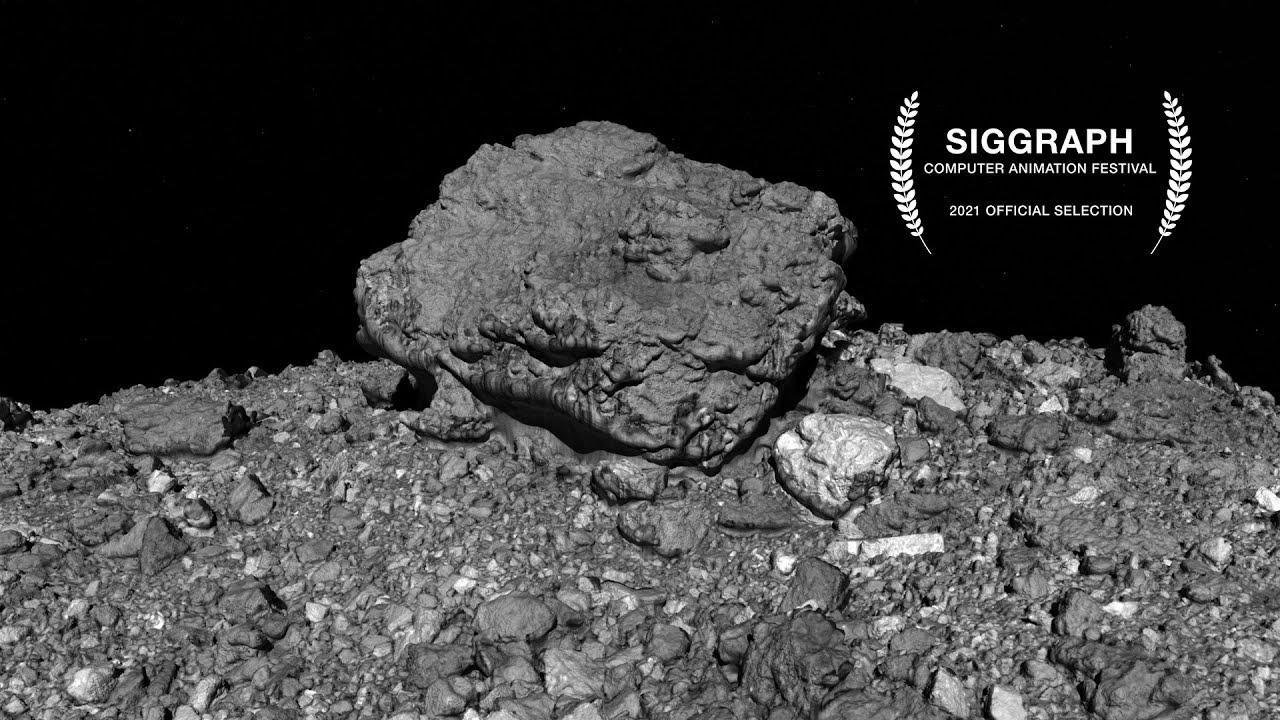
An image of the ground of the asteroid Bennu, studied for mining purposes[64]
Asteroids are also of great interest. The Japanese aerospace agency JAXA launched a mission, Hayabusa2, to the asteroid Ryugu in 2014. The probe collected soil and landed several autonomous robots on the asteroid to study the underlying rocks using a copper bollard to create a crater. The capsule containing the collected samples successfully landed on Earth in 2020. As for the spacecraft itself, its mission has been extended and will study other asteroids in the future[65]. Another sample of asteroidal material will arrive on Earth already this year. It will be delivered by the OSIRIS-REx mission, which studied the asteroid Bennu from 2018 to 2021[66].
Despite its small size (500 m in diameter), Bennu proved to be a very interesting celestial body. It turned out to be a rather loose object, studded with a lot of large rocky debris and occasionally throwing lumps into space. During the sampling there was a risk that OSIRIS-REx would fall into it, like into a pool full of stone balls. After dropping the capsule with the matter samples from Bennu, OSIRIS-REx headed for a rendezvous with Apophis, once the most dangerous asteroid in the solar system. The rendezvous will take place in 2029[67].
The DART mission raised the bar, changing the asteroid’s orbit. It was the practical implementation of the plan to protect the Earth from a threatening celestial body by means of kinetic action. DART’s target was the 160-metre asteroid Dimorph, which is a satellite of the larger object Didim. DART’s collision with the asteroid occurred on 26 September 2022. DART hit Dimorph at a speed of 6.6 km/s. The result, the scientists claim, exceeded their expectations many times over: the change in Dimorph’s orbital period was reduced by 32 minutes, although a reduction of only 73 seconds would be considered a success[68].
This all sounds easy, but in reality it is fraught with risks. Not all space launches are successful, but even if a launch goes well, there are many unexpected situations that can happen in space. Space debris poses a very high collision risk, regardless of what the object encounters: a meteorite or an abandoned satellite is as dangerous as a flake of paint[69]. Regardless of size, while large debris objects are categorised, small particles (1 to 10 cm) are not, but can still play a fatal role[70].
Malfunctions, equipment or software malfunctions, as well as communication problems, can put the mission at risk. In addition, the environment in which spacecraft operate is unstable and under the influence of the space environment the spacecraft may be exposed to radiation, solar wind and dust, magnetic effects and other factors that may damage the vehicle or affect the quality of the data acquired[71].
Landing on a space body can be dangerous because the surface may be uneven or contain dangerous objects, such as sharp rocks or reefs. Or depressions, as happened to Philae (made by the European Space Agency), whose mission was to probe the nucleus of comet Churyumov-Gerasimenko. Due to the comet’s low gravity, the vehicle had to use its proximity motor and harpoon to dock, but the instruments failed and Philae bounced twice off the comet. Only on the third time did it stop, but it ended up in a depression where it quickly ran out of power, since it runs on solar panels, and ‘fell asleep’. Attempts to wake it up were in vain[72]: a confluence of different factors led to the failure of the mission. However, every misstep is a huge step forward and, thanks to modern technology and scientific advances, most of the risks involved in space exploration are minimised and controlled.
Is there anyone else besides us?

A study by astrophysicist Adam Frank on the possible ecological collapse of an alien civilisation[73]
Are we alone in the Universe? I think this is a question that is asked by anyone who thinks about the cosmos. There are many organisations that have set out to answer this question. The SETI Institute (Search for Extraterrestrial Intelligence Institute, California, USA) is a non-profit research organisation founded in 1984 to search for intelligent life in the universe. The institute looks for radio signals that might indicate the presence of alien civilisations, studies the possibility of life on other planets, analyses data on candidate planets and conducts various experiments aimed at finding and studying intelligent life. Their activities are funded by public and private sources.
Using an Allen Telescope Array, consisting of 42 antennas with a diameter of 6.1 metres, the SETI Institute picks up radio signals from space, searching for intelligent life. On the basis of the ATA Data Centre, it has processed and analysed large amounts of data from the radio telescopes. It also uses ground-based telescopes in different parts of the world, such as the Green Bank Telescope in West Virginia or the Parkes Telescope in Australia[74].
Or there is Breakthrough Listen, a private science project established in 2015 to search for alien civilisations in the universe. The project uses powerful radio telescopes around the world to detect electromagnetic signals from space that could be linked to life beyond Earth. It uses high-precision receivers and data processing algorithms that can detect unusual signals from only non-natural sources[75].
These organisations conduct various scientific projects and missions and collaborate with each other and with other research groups and organisations, such as NASA, to share data and work together. The search for intelligent life is about to receive a major instrumental boost in the form of the Square Kilometer Array (SKA), an international project to build a scientific infrastructure for radio astronomy research. The SKA will consist of thousands of antennas located in clusters in different countries, with a diameter of more than 1 kilometre and a photosensitive surface area of several million square metres.
The SKA is expected to be much more sensitive than existing radio telescopes and will be used for a variety of scientific investigations, including the study of the mysteries of matter and dark energy, as well as the evolution of galaxies and the origin of life in the universe. The SKA is in the design and construction phase and should be completed by 2030[76]. But the hope and fear of encountering alien civilisations excites everyone, scientists or not.
Curiosity or profit?
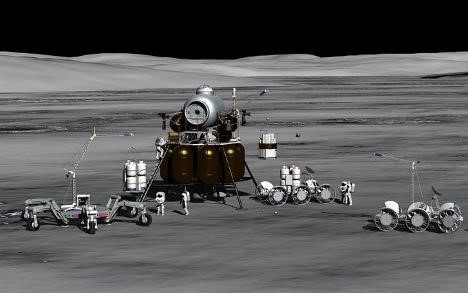
NASA’s Altair module with cargo capsules, capable of transporting 15 tonnes of equipment to the lunar surface[77]
It is not just about dreams and a thirst for knowledge. Exploration of other planets and interstellar space helps scientists better understand how processes in the universe take place, such as the formation and life cycle of stars, planets and other bodies, the origin of life, which in turn deepens our knowledge of our own planet, its origins and history. But today, humanity is trying to exploit the resources of space, which seem very attractive. How realistic are the space industry’s capabilities to extract them?
Data on the mineral composition of small bodies, such as asteroids, are currently very scarce to be able to say that they have relevant potential. Furthermore, in order to carry out a real asteroid and comet research mission, it would be necessary to create a docking system for a low-mass celestial body that would be equally effective for a monolithic asteroid, a friable cometary nucleus, or a hypothetical rock cluster[78].
Another valuable resource is the Moon. The construction of a space base on the Moon could facilitate future space missions, allowing it to be used as a stopping point for flights to other planets and asteroids. Our satellite could also become a site for scientific research, such as astronomy and physics. Thanks to the lack of atmosphere, scientists can study space objects without distortion or interference. One of the best known projects is Artemis, developed by the US space agency NASA. The goal is to create a permanent base on the Moon by 2024 and ensure a sustainable human presence on the Moon in the long term[79].
But projects of this kind require enormous resources from Earth. Only with huge energy reserves in the form of a constant flow of solar energy would it be economically feasible to extract metals from the lunar soil, which is half silicon and half metal oxides, and to produce oxygen by-products. Metals (as construction materials) and oxygen (as an oxidant for rocket fuel and as a gas needed for astronauts’ breathing) can be cost-effectively extracted on the Moon, which means that extracting minerals in situ for the lunar industry would be more efficient than shipping them from Earth. But the benefits of supplying raw materials for Earth’s industry from outer space are questionable[80].
No one has yet started industrial space exploration, but this could lead to serious controversy in the future, given the lack of a legal framework regulating space exploration and liability for its violation, which allows for a very loose interpretation of the principle proclaiming outer space to be the ‘province of all mankind’. The first alarm bells were the US law HR 2262 of 2015[81], which gives US citizens property rights to resources extracted outside the borders of planet Earth, and a similar law adopted by the government of Luxembourg in 2017[82]. For now, however, these are only hypotheses. Our progress is certainly impressive, but on the Kardashev scale, which ranks the technological development of civilisations, we still do not even reach level one[83], and we resemble a small child, with many unanswered questions, in front of an infinite universe.
Of course. But we are growing.
[1] https://www.nasa.gov/mission_pages/hubble/main/index.html
[2] https://www.jwst.nasa.gov/
[3] https://tonkosti.ru/%D0%98%D1%81%D1%82%D0%BE%D1%80%D0%B8%D1%8F_%D0%BE%D1%81%D0%B2%D0%BE%D0%B5%D0%BD%D0%B8%D1%8F_%D0%BA%D0%BE%D1%81%D0%BC%D0%BE%D1%81%D0%B0
[4] https://nssdc.gsfc.nasa.gov/planetary/chronology.html#2020
[5] https://epizodsspace.airbase.ru/bibl/spaceage/11.htm#8
[6] https://www.scienceabc.com/innovation/gravitational-slingshot-how-did-gravity-assist-voyager-1-2-in-escaping-the-solar-system.html
[7] https://bgr.com/science/something-terrifying-is-happening-at-the-border-of-our-solar-system/
[8] https://www.nasa.gov/centers/ames/missions/archive/pioneer.html
[9] https://www.nasa.gov/feature/50-years-ago-pioneer-10-launches-to-explore-jupiter
[10] https://www.nasa.gov/feature/50-years-ago-pioneer-10-launches-to-explore-jupiter
[11] https://dzen.ru/media/deep_cosmos/chto-stalo-s-zondami-pioner10-i-pioner11-607ae95c19675453a5cdd368?utm_referer=www.google.com
[12] https://prokocmoc.ru/issledovaniya/kosmicheskij-apparat-pioner-11/
[13] https://solarsystem.nasa.gov/missions/pioneer-11/in-depth/
[14] https://solarsystem.nasa.gov/news/911/10-things-unsolved-mysteries-of-saturns-moons/
[15] https://dzen.ru/media/deep_cosmos/chto-stalo-s-zondami-pioner10-i-pioner11-607ae95c19675453a5cdd368
[16] https://solarsystem.nasa.gov/missions/pioneer-11/in-depth/
[17] https://cosmos.vdnh.ru/izdoma/kosmicheskie-apparaty-za-predelami-solnechnoy-sistemy/
[18] https://dzen.ru/media/kosmos_x/kratkaia-istoriia-zondov-voiadjer1-i-voiadjer2-5c1628b49ccc0700ae5f4555
[19] http://lgbtkvartal.com/topic/1342-%D0%B2%D0%BE%D1%8F%D0%B4%D0%B6%D0%B5%D1%80-1-%D0%B8-%D0%B2%D0%BE%D1%8F%D0%B4%D0%B6%D0%B5%D1%80-2-%D0%B3%D0%BB%D0%B0%D0%B7%D0%B0-%D1%81%D0%BE%D0%BB%D0%BD%D0%B5%D1%87%D0%BD%D0%BE%D0%B9-%D1%81%D0%B8%D1%81%D1%82%D0%B5%D0%BC%D1%8B-%D0%B8%D1%81%D1%82%D0%BE%D1%80%D0%B8%D1%8F-%D0%B8-%D0%BA%D0%BE%D0%BD%D1%81%D1%82%D1%80%D1%83%D0%BA%D1%86%D0%B8%D1%8F-%D0%B7%D0%BE%D0%BD%D0%B4%D0%BE%D0%B2-%D1%87%D0%B0%D1%81%D1%82%D1%8C-1/
[20] http://lgbtkvartal.com/topic/1342-%D0%B2%D0%BE%D1%8F%D0%B4%D0%B6%D0%B5%D1%80-1-%D0%B8-%D0%B2%D0%BE%D1%8F%D0%B4%D0%B6%D0%B5%D1%80-2-%D0%B3%D0%BB%D0%B0%D0%B7%D0%B0-%D1%81%D0%BE%D0%BB%D0%BD%D0%B5%D1%87%D0%BD%D0%BE%D0%B9-%D1%81%D0%B8%D1%81%D1%82%D0%B5%D0%BC%D1%8B-%D0%B8%D1%81%D1%82%D0%BE%D1%80%D0%B8%D1%8F-%D0%B8-%D0%BA%D0%BE%D0%BD%D1%81%D1%82%D1%80%D1%83%D0%BA%D1%86%D0%B8%D1%8F-%D0%B7%D0%BE%D0%BD%D0%B4%D0%BE%D0%B2-%D1%87%D0%B0%D1%81%D1%82%D1%8C-1/
[21] https://voyager.jpl.nasa.gov/mission/spacecraft/instruments/
[22] https://dzen.ru/media/kosmos_x/kratkaia-istoriia-zondov-voiadjer1-i-voiadjer2-5c1628b49ccc0700ae5f4555
[23] https://ikfia.ysn.ru/voyadzhery/
[24] https://news.mail.ru/society/50975224/
[25] https://voyager.jpl.nasa.gov/mission/timeline/#event-nasas-voyager-2-probe-enters-interstellar-space
[26] https://universemagazine.com/ru/voyager-2-y-masshtaby-solnechnoj-systemy/
[27] https://kosmolenta.com/index.php/129-2014-09-15-voyager
[28] https://voyager.jpl.nasa.gov/mission/status/#where_are_they_now
[29] https://nauchkor.ru/media/gde-zakanchivaetsya-solnechnaya-sistema-58a211285f1be7192ee4eb28
[30] https://universemagazine.com/ru/voyager-2-y-masshtaby-solnechnoj-systemy/
[31] https://postnauka.ru/video/76482
[32] https://universemagazine.com/ru/voyager-2-y-masshtaby-solnechnoj-systemy/
[33] https://academic.oup.com/mnras/article/140/4/537/2604425?login=false
[34] https://starwalk.space/ru/news/kuiper-belt
[35] https://www.nasa.gov/mission_pages/newhorizons/spacecraft/index.html
[36] https://www.britannica.com/topic/New-Horizons
[37] https://solarsystem.nasa.gov/missions/new-horizons/in-depth/
[38] https://www.planetarium-moscow.ru/about/news/transneptunovyy-asteroid-arrokot2021/
[39] https://solarsystem.nasa.gov/missions/new-horizons/in-depth/
[40] https://voyager.jpl.nasa.gov/mission/science/ ; https://www.nasa.gov/centers/ames/missions/archive/pioneer10-11.html ; https://www.nasa.gov/mission_pages/newhorizons/spacecraft/index.html
[41] https://www.wikiwand.com/ru/%D0%94%D0%B0%D0%BB%D1%8C%D0%BD%D1%8F%D1%8F_%D0%BA%D0%BE%D1%81%D0%BC%D0%B8%D1%87%D0%B5%D1%81%D0%BA%D0%B0%D1%8F_%D1%81%D0%B2%D1%8F%D0%B7%D1%8C
[42] https://quizlet.com/550478253/beyond-our-solar-system-diagram/
[43] https://www.space.com/ibex-mission.html
[44] http://parkersolarprobe.jhuapl.edu/
[45] https://www.vokrugsveta.ru/vs/article/5956/
[46] https://www.vokrugsveta.ru/vs/article/5956/
[47] https://www.vokrugsveta.ru/vs/article/5956/
[48] https://aboutspacejornal.net/2017/11/19/%D0%BA%D0%BE%D1%81%D0%BC%D0%B8%D1%87%D0%B5%D1%81%D0%BA%D0%B0%D1%8F-%D1%81%D0%B2%D1%8F%D0%B7%D1%8C/
[49] https://eyes.nasa.gov/dsn/dsn.html
[50] https://habr.com/ru/company/yota/blog/350168/
[51] https://www.nasa.gov/directorates/heo/scan/services/networks/deep_space_network/about
[52] https://habr.com/ru/company/yota/blog/350168/
[53] https://www.vokrugsveta.ru/vs/article/5956/
[54] https://hi-news.ru/eto-interesno/voyadzher-samyj-bystryj-kosmicheskij-apparat-vo-vselennoj.html
[55] https://www.space.com/voyager-1-telemetry-issue
[56] https://www.iguides.ru/main/other/voyadzher_2_pochti_vyletel_iz_solnechnoy_sistemy_chto_zhdet_ego_vperedi/
[57] https://mars.nasa.gov/resources/27262/perseverances-three-forks-sample-depot-selfie/
[58] https://www.space.com/china-yutu-2-moon-rover-3-years-panorama
[59] https://www.space.com/china-moon-rover-finds-strange-glass-spheres
[60] https://mars.nasa.gov/msl/mission/overview/
[61] https://www.ixbt.com/live/offtopic/10-let-na-marse-kakie-otkrytiya-sdelal-marsohod-curiosity.html
[62] https://mars.nasa.gov/mars2020/timeline/surface-operations/
[63] https://www.esa.int/Science_Exploration/Human_and_Robotic_Exploration/Exploration/ExoMars
[64] https://www.youtube.com/watch?v=QunVAWABQSc
[65] https://www.hayabusa2.jaxa.jp/en/
[66] https://www.nasa.gov/osiris-rex
[67] https://maxpolyakov.com/ru/asteroidy-missii/
[68] https://www.nasa.gov/planetarydefense/dart/dart-news
[69] https://www.nasa.gov/offices/nesc/articles/space-debris
[70] https://www.esa.int/About_Us/ESOC/Space_debris_assessing_the_risk
[71] https://www.captechu.edu/blog/hazards-of-space-how-satellite-missions-can-go-wrong
[72] https://nauka.tass.ru/nauka/6822949
[73] https://www.rochester.edu/newscenter/astrobiology-alien-apocalypse-can-any-civilization-make-it-through-climate-change-322232/
[75] https://breakthroughinitiatives.org/initiative/1
[77] https://astronomy.com/news/2020/11/is-space-mining-the-eco-friendly-choice
[78] https://www.vesvks.ru/vks/article/issledovanie-i-promyshlennoe-osvoenie-kosmicheskih-16550
[79] https://www.nasa.gov/specials/artemis/
[80] https://www.vesvks.ru/vks/article/issledovanie-i-promyshlennoe-osvoenie-kosmicheskih-16550
[81] https://www.congress.gov/bill/114th-congress/house-bill/2262
[82] https://cyberleninka.ru/article/n/initsiativa-lyuksemburga-spaceresources-lu-i-vozmozhnye-posledstviya-dlya-regulirovaniya-mirovogo-rynka-kosmicheskoy-deyatelnosti
Leave a Reply